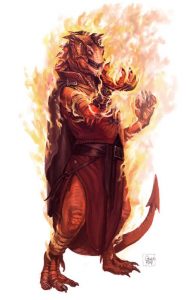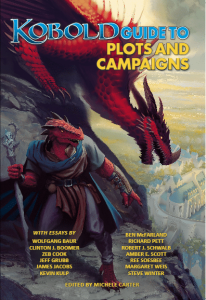Essays are the bane of students at all levels of academia, but I’ve always, always loved them. I loved the challenge of making my point in 3-5 pages; delivering something worthy of reading in around 1,000 words. This is part of why writing for NoE is such an enjoyable thing for me.
As it turns out, the folks over at Kobold Press share my love for essays! They’ve got a great series of curated essays called Kobold Guide To ______________________ , where the blank is filled with all sorts of treats like world building, combat, magic, board game design, and more.
The kobold contributors boast an Intelligence stat well north of the 8 the Monster Manual attributes to them. Indeed, we here at Nerds on Earth are thinking that stat is at least double that!
In the latest Kobold Guide, thirteen writers pen nineteen essays with plots and campaigns in mind. Each and every last one of the essays brings something valuable to the table for DMs/GMs to consider should they attempt to build a roleplaying campaign from the ground up instead of utilizing published modules.
Below, I pick my five favorite essays from the book!
Kobold Guide to Plots and Campaigns: 5 Favorite Essays![cover kobold press guide to plots and campaigns]()
1. “Take a Walk on the Dark Side” by Robert J. Schwalb.
There are probably a thousand articles all over the internet explaining that campaigns simply cannot be run with evil aligned PCs, plus an article here that says while permissible, it might not be advisable, so it was a pleasantly unexpected experience to read an argument to the contrary.
Schwalb is open and honest about the difficulties of such an undertaking and even comments on the longevity one can expect from a party comprised of evil aligned PCs (they “rarely last”), but he lays out some really intriguing mechanics to delay that as long as possible including:
- Making the PCs the henchmen of a much more powerful and evil patron to tighten their leash
- Giving the usually self-serving evil PCs a common goal/enemy to unite them
- Orchestrating appropriate and real consequences for any evil deeds done in the world
And more. If nothing else, it would make for a fun experiment!
2. “When Last We Left Our Intrepid Heroes” by Clinton J. Boomer.
Boomer looks to television’s episodic storytelling format for inspiration designed to enhance our tabletop gaming experiences. I found his “Previously, on…” game recaps and episode guides to be well in line not only with what I heard at a number of panels at Dragon*Con (get yourself a game historian!) but also with what I see in some of my favorite podcasts (giving fun names to sessions like “Summon-Where Over the Pain-Bow” instead of saying “three or four sessions ago…”).
More than serving as a handy reference system, the advice Boomer provides can help keep players looking forward to the next “episode.”
3. “Crooked Characters” by Richard Pett.
This essay provides two tables (Traits and Crooks) that can be utilized in conjunction with one another to quickly roll up memorable NPCs where Trait + Crook = NPC. After providing the tables, Pett provides examples of NPCs he rolled with one, two, and three traits. The more traits you roll, the more complex and memorable your NPC…if you build and play them well from the foundation provided from the tables.
Super cool resource that I plan on referring to on a regular basis and it stacks well with our table of quirks!
4. “Pacing, Beats, And The Passage of Time” by Wolfgang Baur.
This might have been the most enlightening of the essays to me personally.
What do you mean I should consider dropping some combat encounters from my sessions?!
Well, that is part of Baur’s argument and it is augmented by attempting to make more encounters (even minor and random ones) to feel more like a part of the story than just the outcome of a d12 roll from a table. He feels that “memory and narrative change” are the real keys to a campaigns strength and pacing. It definitely has me thinking a lot!
5. “Complex Plotting” by Kevin Kulp.
Kulp takes the word “complex” and makes it exceedingly simple. By leveraging hooks, schemas, and recurring characters (among other things), we, as DMs/GMs, can develop the narratives the PCs are writing with ease. They retain complete narrative control and we only do the work we have to–as opposed to pouring hours of effort into potential plot lines only have the PCs find another direction more intriguing.
And the best part: It feels organic to all involved.
Kobold Guide to Plots and Campaigns: Bonus Content!![keep-calm-and-roll-for-initiative-7]()
I know you only signed up to read about my five favorite essays, but truth be told – I sat down to the book expecting to read only essays and was treated to a little something more at the end. So why would I rob you of a similar treat?!
The closing few pages of the book is actually an outline of a 4 hour adventure designed to be improved using techniques, tricks, and resources provided in the preceding pages.
I love this addition! It’s kinda like shop class back in the day: the teacher walks you through all the materials you’ll need and provides you with the right tools for the job, and then invites you to build a birdhouse.
Only your birdhouse in this case is a custom adventure. Pretty cool!
Kobold Guide to Plots and Campaigns: Improving Your DM/GM Game
With enough practice with the tools provided in Kobold Guide to Plots and Campaigns, you’ll graduate from 4 hour adventures to world-scale campaigns. If you’ve got the itch to design adventures from scratch or have a seedling of an idea that you’d love to explore, this book is for you. Even if you’ve got plenty of experience, you’re sure to pick up a new trick, practice, or resource within.
And there is no doubt that we’d gladly pay $18 to step up our DM/GM game; even if only a bit.
You can get Kobold Guide to Plots and Campaigns from Amazon, but you can also look for it and the other Kobold Guides straight from the Kobold Store or in your friendly local gaming store.
[Disclosure: Nerds on Earth was provided a copy of Kobold Guide To Plots and Campaigns for review purposes. You can read our policy here.]



